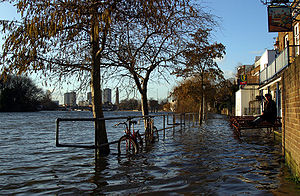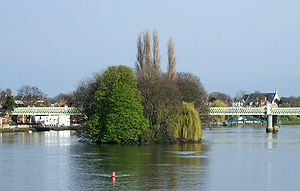
Strand-on-the-Green
Encyclopedia

Chiswick
Chiswick is a large suburb of west London, England and part of the London Borough of Hounslow. It is located on a meander of the River Thames, west of Charing Cross and is one of 35 major centres identified in the London Plan. It was historically an ancient parish in the county of Middlesex, with...
in west London
London
London is the capital city of :England and the :United Kingdom, the largest metropolitan area in the United Kingdom, and the largest urban zone in the European Union by most measures. Located on the River Thames, London has been a major settlement for two millennia, its history going back to its...
.
Location and description

Kew Bridge
Kew Bridge is a bridge in London over the River Thames. The present bridge was designed by John Wolfe-Barry and opened in 1903 by King Edward VII. The bridge was givenGrade II listed structure protection in 1983.- Location :...
, along the north bank of the river Thames
River Thames
The River Thames flows through southern England. It is the longest river entirely in England and the second longest in the United Kingdom. While it is best known because its lower reaches flow through central London, the river flows alongside several other towns and cities, including Oxford,...
. The name is shared by the first part of the road east of Kew Bridge, its continuation on the riverside path, and the area itself.
The area is renowned as a particularly picturesque part of London
London
London is the capital city of :England and the :United Kingdom, the largest metropolitan area in the United Kingdom, and the largest urban zone in the European Union by most measures. Located on the River Thames, London has been a major settlement for two millennia, its history going back to its...
. A footpath runs along the bank of the river, overlooked by numerous imposing 18th-century houses and local pubs, and, being on the Tideway
Tideway
The Tideway is a name given to the part of the River Thames in England that is subject to tides. This stretch of water is downstream from Teddington Lock and is just under long...
, is regularly flooded.
The District Line
District Line
The District line is a line of the London Underground, coloured green on the Tube map. It is a "sub-surface" line, running through the central area in shallow cut-and-cover tunnels. It is the busiest of the sub-surface lines. Out of the 60 stations served, 25 are underground...
and London Overground
London Overground
London Overground is a suburban rail network in London and Hertfordshire. It has been operated by London Overground Rail Operations since 2007 as part of the National Rail network, under the franchise control and branding of Transport for London...
both cross the river on the railway bridge erected in 1869 between the City Barge and Bull's Head pubs.
Historic local pubs
Moving downstream (from west to east), the three pubs along the river at Strand-on-the-Green are:- The Bell & Crown; licensed by 1751, closest to Kew Bridge.
- The City Barge; licensed by 1786. This pub was known as the Maypole Inn until 1807, when it was renamed for the City barge moored nearby. The pub was largely destroyed by a bomb during World War IIWorld War IIWorld War II, or the Second World War , was a global conflict lasting from 1939 to 1945, involving most of the world's nations—including all of the great powers—eventually forming two opposing military alliances: the Allies and the Axis...
, and the old bar is all that remains of the original inn. Featured in the 1965 Beatles film Help! - The Bull's Head; licensed by 1722, farthest east from Kew Bridge.
History to c.1750
Over 100 human skulls were reportedly found in the river Thames opposite Strand-on-the-Green during the 19th century, and although they have since disappeared, dating of other similar river skulls suggests they may have dated from c.600 BC.Pottery dating from Roman
Ancient Rome
Ancient Rome was a thriving civilization that grew on the Italian Peninsula as early as the 8th century BC. Located along the Mediterranean Sea and centered on the city of Rome, it expanded to one of the largest empires in the ancient world....
times has also been found in Strand-on-the-Green.
Strand-on-the-Green is first recorded as "Stronde" in 1353 ('strand' probably means 'shore'). It was called 'Strand Green' in 1593 and 'Strand under Green' in 1760. Almshouses, first built in 1658, still remain, though they were replaced by new buildings in 1721-24.
It was one of the four villages (Chiswick, Little Sutton, Turnham Green and Strand-on-the-Green) that merged to form the present-day Chiswick
Chiswick
Chiswick is a large suburb of west London, England and part of the London Borough of Hounslow. It is located on a meander of the River Thames, west of Charing Cross and is one of 35 major centres identified in the London Plan. It was historically an ancient parish in the county of Middlesex, with...
.
History since c.1750
The opening of Kew Bridge in 1759 (which replaced a ferry on the same spot) and the royal palace at KewKew Palace
Kew Palace is a British Royal Palace in Kew Gardens on the banks of the Thames up river from London. There have been at least four Palaces at Kew, and three have been known as Kew Palace; the first building may not have been known as Kew as no records survive other than the words of another...
increased the importance and popularity of the area, prompting the building of large houses and the development of small industries along the waterfront. These industries included malt-houses, repair yards, barge-builders and wharves. By 1860, Strand-on-the-Green also housed one of the largest laundries in London, the Pier House Laundry, whose brick facade is still visible to the left of Cafe Rouge. The laundry eventually closed in 1973.
The area began a slow decline in the 19th century when the Grand Junction Canal
Grand Junction Canal
The Grand Junction Canal is a canal in England from Braunston in Northamptonshire to the River Thames at Brentford, with a number of branches. The mainline was built between 1793 and 1805, to improve the route from the Midlands to London, by-passing the upper reaches of the River Thames near Oxford...
diverted freight traffic to Brentford, and the royal family
Royal family
A royal family is the extended family of a king or queen regnant. The term imperial family appropriately describes the extended family of an emperor or empress, while the terms "ducal family", "grand ducal family" or "princely family" are more appropriate to describe the relatives of a reigning...
moved from Kew to Windsor
Windsor Castle
Windsor Castle is a medieval castle and royal residence in Windsor in the English county of Berkshire, notable for its long association with the British royal family and its architecture. The original castle was built after the Norman invasion by William the Conqueror. Since the time of Henry I it...
. Strand-on-the-Green has now become a residential area once again, and was described in 1932 as "London's last remaining village".
During World War II, 41 houses in Thames Road and Magnolia Road were destroyed and a further 60 were severely damaged when a parachute mine
Parachute mine
A parachute mine is a parachute naval mine dropped from an aircraft. They were mostly used in World War II by the Luftwaffe and initially by the Royal Air Force Bomber Command.-Blast effects:...
landed on September 21, 1941. Scenes from the Beatles'
The Beatles
The Beatles were an English rock band, active throughout the 1960s and one of the most commercially successful and critically acclaimed acts in the history of popular music. Formed in Liverpool, by 1962 the group consisted of John Lennon , Paul McCartney , George Harrison and Ringo Starr...
1965 film Help!
Help! (film)
Help! is a 1965 film directed by Richard Lester, starring The Beatles—John Lennon, Paul McCartney, George Harrison and Ringo Starr—and featuring Leo McKern, Eleanor Bron, Victor Spinetti, John Bluthal, Roy Kinnear and Patrick Cargill. Help! was the second feature film made by the Beatles and is a...
were shot in the City Barge pub and around Strand-on-the-Green.
Oliver's Island

Oliver's Island
Oliver's Island is a small heavily wooded island in the River Thames in England. It is located in the London Borough of Hounslow on the Tideway near Kew, and is opposite Strand-on-the-Green in Chiswick....
is a small eyot in the river Thames opposite Strand-on-the-Green. It acquired its name after rumours that Oliver Cromwell
Oliver Cromwell
Oliver Cromwell was an English military and political leader who overthrew the English monarchy and temporarily turned England into a republican Commonwealth, and served as Lord Protector of England, Scotland, and Ireland....
used the island as a hideout and held military councils at the Bull's Head pub during the English Civil War
English Civil War
The English Civil War was a series of armed conflicts and political machinations between Parliamentarians and Royalists...
, but there is no hard evidence to support these rumours. The City of London's Navigation Committee erected buildings on the island after 1777, and barges were also stationed here for the collection of tolls.
Famous residents
One of the houses overlooking the river (No. 65) is marked with a blue plaqueBlue plaque
A blue plaque is a permanent sign installed in a public place to commemorate a link between that location and a famous person or event, serving as a historical marker....
noting that the 18th century portrait painter Johann Zoffany
Johann Zoffany
Johan Zoffany, Zoffani or Zauffelij was a German neoclassical painter, active mainly in England...
lived there at the end of his life. Donald Pleasence
Donald Pleasence
Sir Donald Henry Pleasence, OBE, was a British actor who gained more than 200 screen credits during a career which spanned over four decades...
used to live in Strand-on-the-Green. Current residents include actor Rhys Ifans
Rhys Ifans
Rhys Ifans is a Welsh actor and musician. He is known for his portrayal of characters such as Spike in Notting Hill and Jed Parry in Enduring Love and as a member of the Welsh rock groups Super Furry Animals and The Peth. Ifans also appeared as Xenophilius Lovegood in Harry Potter and the Deathly...
and the television entertainers Ant and Dec all live in the area.

